Papers by Colleen M Berryessa
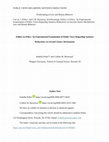
Law and Human Behavior, 2025
Objective(s): This research examines how the cost of incarceration to the state and type of offen... more Objective(s): This research examines how the cost of incarceration to the state and type of offense affects public support for different levels of sentence reductions (10%, 25%, 50%) via policies that reduce incarcerated populations called “second chance” mechanisms, as well as whether political ideology or affiliation predicts such support. Hypotheses: (1) Across different levels of sentence reductions, participants were expected to show significantly decreased support for the use of second chance mechanisms for violent compared to nonviolent crimes, (2) but also show significantly increased support when exposed to cost information to the state, compared to not receiving that information. (3) Political ideology and affiliation were expected to moderate support across different levels of sentence reductions. Method: A 6 (offense type) x 2 (cost of incarceration to the state) experiment with a national sample of the U.S. public (N = 419) was used to assess support for using second chance mechanisms to achieve different levels of sentence reductions. Moderation analyses assessed how participants’ political ideology and affiliation impacted support. Results: Participants did not show significantly less support for the use of second chance mechanisms to achieve sentence reductions for violent, compared to non-violent, crimes. Providing cost information did not significantly impact support for any level of sentence reduction. Across sentence reductions, political ideology significantly moderated support for the use of second chance mechanisms, where being more conservative predicted decreased support for a 10% sentence reduction when cost information was also provided. Conclusions: Crime type and political ideology, but not fiscal costs, appear in some way to bear on public support for sentence reductions via second chance mechanisms. Overall, evidence suggests that public support for the use of second chance mechanisms presents an opportunity to advance reforms that reduce incarcerated populations and enhance the public's perceptions of the justice system’s legitimacy.
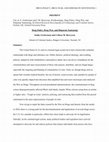
Oxford Research Encyclopedia of Criminology and Criminal Justice, 2024
The United States and its criminal-legal system have had a historically turbulent relationship wi... more The United States and its criminal-legal system have had a historically turbulent relationship with drugs and substance use. Public rhetoric, political ideology, and resulting policies, shaped by both rehabilitative and punitive ideals, have served as a foundation for the criminalization and mass incarceration of those who possess, distribute, and use illegal drugs—especially the targeting and blaming of communities of color. Early on, although drugs such as opium had versatile medical benefits, the use of heroin, crack/cocaine, and cannabis by people of color was quickly shaped into a discourse that amplified fear and racist stereotypes and catalyzed the War on Drugs. Throughout several presidential administrations, the criminalization of drug crimes disproportionately affected Black individuals, despite White citizens using them at similar or higher rates. “Tough on crime” policies, policing, and sentencing that resulted from this period culminated in the mass imprisonment of people of color.
Trying to repair the harm caused by the War on Drugs and rhetoric from the media in 2024, there is a strong push for the decriminalization and legalization of several drugs across the United States. For cannabis in particular, efforts have been made to advocate for its legalization federally. In the criminal-legal system, many political leaders and legislators have actively attempted to advocate for and enforce policies that release individuals from prison who have been incarcerated for minor drug offenses or are affected by unjust sentencing practices. Combined with nationwide efforts to promote research on the use of drugs for medicinal purposes, as well as the problems of drug abuse and addiction, a more progressive and optimistic approach to drug use has begun and continues to grow across the United States. The social and political forces that have historically shaped attitudes toward drug use and punishment are crucial to understanding the direction of U.S. drug policies in the early 21st century and why the pendulum continues to swing.

Journal of Experimental Criminology, 2024
Objectives: This study examines how a defendant's addiction, prior criminal record, race, and dru... more Objectives: This study examines how a defendant's addiction, prior criminal record, race, and drug type impact public support for criminalized and medicalized sentencing approaches to illegal drug use, as well as how such support may be moderated by participants' levels of essentialist thinking. Methods: A fully-crossed, randomized experiment with a lay public sample (N=1,208). Results: Public support for medicalized approaches to sentencing was significantly higher for oxycodone and heroin. Support for criminalized approaches was significantly higher for crack and cocaine, and when the defendant was Hispanic, Black, or had a violent criminal record. Essentialist thinking generally predicted increased support for criminalized approaches, but increased support for medicalized approaches when addiction was known. Conclusions: This research highlights the role of different factors in shaping public support for drug sentencing approaches, as well as suggests that public attitudes about drugs are deeply intertwined with societal narratives about race, addiction, and criminality.
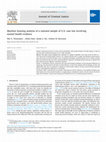
Journal of Criminal Justice, 2024
Purpose: Sentencing practices in cases involving defendants with mental disorders are often opaqu... more Purpose: Sentencing practices in cases involving defendants with mental disorders are often opaque, as data on case facts and sentencing decisions are not easily accessible.
Methods: This paper reports findings from a national U.S. sample of appellate court cases across 46 states (n = 710) that involved mental health evidence. We collected detailed data on judge and defendant characteristics, type and severity of mental disorders, state sociopolitical ideologies, and legal factors such as offense and plea type and criminal history. We used a mixed quantitative approach, including machine learning, to examine how these intricate factors influence sentencing outcomes.
Results: A combination of linear regressions and supervised learning techniques reveals important differences in sentencing outcomes based on the type of mental disorder as well as the majority political ideology of states. We additionally show that, as compared to arguing no mental health evidence, having a mental disorder generally did not yield significant differences in sentencing.
Conclusions: Both a potential lack of scientific comprehension and the influence of sociopolitical ideology may help explain why certain mental disorders are aggravating in punishment contexts. We also discuss the advantages and limitations of supervised learning and classification trees for studying judicial decisions.

Law and Human Behavior, 2024
Objective: Existing literature has yet to conceptualize and consolidate research on psychological... more Objective: Existing literature has yet to conceptualize and consolidate research on psychological essentialism and its relation to the criminal-legal system, particularly in terms of explaining how justice-involved individuals have been and could be differentially impacted across contexts. This paper explores essentialism in the criminal-legal system, including its potential consequences for inequity. Methods: We review research on essentialism as a psychological construct, its common applications to different social categorizations, and its trickle-down effects within the criminal-legal system. Results: Empirical work suggests that biases stemming from essentialism have the potential to severely affect individuals within the criminal-legal system. Beyond assigning immutable properties across social groups, essentialism can give rise to biased attributions of responsibility and blame and affect decisions and behavior within three core domains of the criminal-legal system: jury decision-making, sentencing decisions, and public support for punitive policies. Conclusions: We propose future policy recommendations to mitigate the adverse effects of essentialism in the criminal-legal system, which especially focus on how using and adopting person-first language (focusing on people before characteristics) across society and policy can help to combat bias across criminal-legal domains. Future research is needed on how to best address the adverse effects of essentialism and its biasing effects in the criminal-legal system, as well as to examine the effects of essentialism in different legal contexts.

Springer eBooks, 2023
This chapter examines neuromorality and its implications for criminal punishment. Increasing evid... more This chapter examines neuromorality and its implications for criminal punishment. Increasing evidence suggests that morality is neurologically influenced, supporting the concept of neuromorality, according to which brain areas and neural networks underlie morality and moral decision-making. As evidence on neuromorality grows, findings may lead to questions about how immorality and related criminal behavior should be punished in the legal system. After reviewing existing neuroscientific evidence that suggests how distinctive neural deficits can negatively impact moral sense and decision-making, and can contribute to offending, we discuss how such evidence could affect perceptions of moral responsibility. We then explore practical and philosophical implications of neuromorality for determining retributive and utilitarian punishments in the legal system. Finally, we conclude by suggesting ways that neurological factors may be integrated into criminal sentencing.
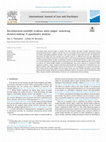
International Journal of Law and Psychiatry, 2024
The present study surveyed judges to examine how they consider and apply scientific information d... more The present study surveyed judges to examine how they consider and apply scientific information during sentencing determinations. Judges in criminal courts are increasingly asked to assess and make decisions based on evidence surrounding psychiatric disorders, with unclear results on sentencing outcomes. We qualitatively interviewed 34 judges who have presided over criminal cases in 16 different states and also administered vignette surveys during the interviews. We asked them to make sentencing decisions for hypothetical defendants in cases presenting evidence of either no psychiatric disorder, an organic brain disorder, or past trauma, as well as to rate the importance of different goals of sentencing for each case. Results indicated that the case presenting no evidence of a mental health condition received significantly more severe sentences as compared to either psychiatric condition. Judges' ratings of sentencing goals showed that the importance of retribution was a significant mediator of this relationship. Trauma was not deemed to be as mitigating as an organic brain disorder. These results provide unique insights into how judges assess cases and consider sentencing outcomes when presented with scientific information to explicate defendants' behavior. We propose ways forward that may help better integrate scientific understandings of behavior into criminal justice decision-making.

Behavioral Sciences & the Law, 2024
Research suggests that a defendant's history of experiencing childhood abuse, and its effects on ... more Research suggests that a defendant's history of experiencing childhood abuse, and its effects on their life and later decision‐making, may impact public support for a defendant's sentencing, particularly mitigation. However, no existing research has examined how and why sentencing support may vary based on the time period when the abuse occurs during a defendant's childhood. This experiment, using a sample of the U.S. public (N = 400), examines how the age at which a defendant's childhood physical abuse occurs affects lay support for the goals of their sentencing. We hypothesized that participants with higher levels of social and biological trait essentialism would moderate their increased support for more punitive sentencing goals—particularly when a defendant was abused earlier, rather than later, in childhood. Results suggest that social essentialism is associated with increased support for restoration and rehabilitation toward defendants with histories of childhood physical abuse, potentially indicating that the public views the effects of child abuse as more of a social, versus biological, process which may affect support for utilitarian punishment goals.
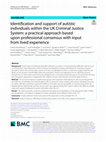
BMC Medicine, 2024
Background Autism spectrum disorder (hereafter referred to as autism) is characterised by difficu... more Background Autism spectrum disorder (hereafter referred to as autism) is characterised by difficulties with (i) social communication, social interaction, and (ii) restricted and repetitive interests and behaviours. Estimates of autism prevalence within the criminal justice system (CJS) vary considerably, but there is evidence to suggest that the condition can be missed or misidentified within this population. Autism has implications for an individual's journey through the CJS, from police questioning and engagement in court proceedings through to risk assessment, formulation, therapeutic approaches, engagement with support services, and long-term social and legal outcomes. Methods This consensus based on professional opinion with input from lived experience aims to provide general principles for consideration by United Kingdom (UK) CJS personnel when working with autistic individuals, focusing on autistic offenders and those suspected of offences. Principles may be transferable to countries beyond the UK. Multidisciplinary professionals and two service users were approached for their input to address the effective identification and support strategies for autistic individuals within the CJS. Results The authors provide a consensus statement including recommendations on the general principles of effective identification, and support strategies for autistic individuals across different levels of the CJS. Conclusion Greater attention needs to be given to this population as they navigate the CJS.
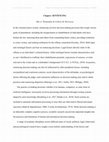
APA Handbook of Forensic Psychology, 2nd edition, 2024
This chapter begins by describing the historical context, standards, goals, and significance of c... more This chapter begins by describing the historical context, standards, goals, and significance of criminal sentencing in the United States (U.S.). In an effort to elucidate the key influences to and practices by which courts reach sentencing decisions, we then describe psychological and cognitive-behavioral theories relevant to sentencing decision-making. After describing these theories and principles guiding our understanding of the cognitive and computational shortcuts involved in decision-making, we review relevant sentencing research and case law. Key legal, extralegal, and extraneous factors that can influence sentencing are also described to provide a more comprehensive view of sentencing decision-making in practice. We then discuss the significance of sociocultural identities and systemic inequalities in sentencing related to past and current practices, as well as concerns regarding the future of sentencing decision-making that may increasingly rely on automation. Finally, policy issues are discussed, with a particular focus
on de-biasing humans, machines, and improving overall sentencing decision-making.
Journal of Crime and Justice, 2024
Drawing from semi-structured interviews, this paper examines the perspectives of 14
criminal just... more Drawing from semi-structured interviews, this paper examines the perspectives of 14
criminal justice stakeholders who were integral in creating and implementing the New Jersey Public Health Emergency Credits Act (2020). Stakeholders, including police administrators, corrections administrators, parole administrators, prison health administrators, and reentry service organization administrators, were interviewed. Stakeholders shared their viewpoints through three phases of the bill (pre-implementation, implementation, and post-implementation), highlighting their struggles with the lack of time and resources to support individuals upon their release, which later impacted their supervision capabilities. Implications suggest that future decarceration efforts may benefit from augmented planning and coordination.
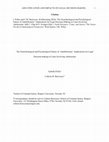
Youth Deviance, Crime, and Justice: The Neuro-Psycho- Criminological Perspective, 2024
Neurobiological and psychological research on the differences between adolescents and adults in c... more Neurobiological and psychological research on the differences between adolescents and adults in criminology and psychology has provided insight into how distinctive developmental processes may contribute to juvenile involvement in crime and the legal system. Literature investigating these differences, particularly regarding deficits in psychological and brain development and their resulting implications for adolescent decision-making, has revealed that youth may require support as they navigate the legal system and that their innate vulnerabilities should potentially necessitate additional safeguards in such environments. However, biases such as adultification-which defines how certain youth, sometimes due to sociodemographic qualities, can be misunderstood as more competent and mature than is indicated by their adolescence-may risk these protections and lead some juveniles to be perceived as less vulnerable and more culpable for their actions before and during the legal process. This chapter discusses the reasons for and ramifications of the adultification of children by legal decision-makers, including how their misperceptions related to adultification can threaten protections for adolescents within various legal processes. Particularly, this chapter describes how judgments regarding juvenile competency, transfer, and sentencing can be misguided by erroneous views of the psychosocial maturity of juveniles who have made contact with the system.

Journal of Criminal Psychology, 2024
Purpose: Neuroscientific research on addictions has prompted a paradigm shift from a moral to a m... more Purpose: Neuroscientific research on addictions has prompted a paradigm shift from a moral to a medical understanding – with substantial implications for legal professionals’ interactions with and decision-making surrounding individuals with addiction. This study complements prior work on U.S. defense attorney’s understandings of addiction by investigating two further perspectives: (a) the potential “next generation” of legal professionals in the U.S. (criminal justice under-graduates) and (b) legal professionals from another system (Germany). Their views on the brain disease model of addiction, dominance and relevance of this model, the responsibility of affected persons, and preferred sources of information were assessed. Design/methodology/approach: Views of 74 U.S. criminal justice undergraduate students and 74 German legal professionals were assessed using Likert Scales and open-ended questions in an online survey. Findings: Neuroscientific research findings on addictions and views that addiction is a brain disease were rated as significantly more relevant by American students to their potential future work than by German legal professionals. However, a majority of both samples agreed that addiction is a brain disease and that those affected are responsible for their condition and actions. Sources of information most frequently used by both groups were publications in legal academic journals. Practical implications: In the U.S., information for legal professionals needs to be expanded and integrated into the education of its “next generation,” while in Germany it needs to be developed and promoted. Legal academic journals appear to play a primary role in the transfer of research on addiction into legal practice. Originality/value: This study complements prior work on U.S. defense attorneys’ understandings of addiction by investigating two further perspectives.
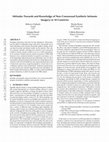
Deepfake technology tools have become ubiquitous, "democratizing" the ability to manipulate image... more Deepfake technology tools have become ubiquitous, "democratizing" the ability to manipulate images and videos. One popular use of such technology is the creation of sexually explicit content, which can then be posted and shared widely on the internet. This article examines attitudes and behaviors related to non-consensual synthetic intimate imagery (NSII) across over 16,000 respondents in 10 countries. Despite nascent societal awareness of NSII, NSII behaviors were considered harmful. In regards to prevalence, 2.2% of all respondents indicated personal victimization, and 1.8% all of respondents indicated perpetration behaviors. Respondents from countries with relevant legislation also reported perpetration and victimization experiences, suggesting legislative action alone is not a sufficient solution to deter perpetration. Technical considerations to reduce harms may include suggestions for how individuals can better monitor their presence online, as well as enforced platform policies which ban, or allow for removal of, NSII content.
International Journal on Responsibility, 2023
This special issue of the International Journal on Responsibility (IJR) advances scholarship on t... more This special issue of the International Journal on Responsibility (IJR) advances scholarship on the various ways responsibility infuses the roles of criminal justice agents. As the inaugural issue of my tenure as Editor-in-Chief, Volume 6 deepens our understanding of responsibility in the context of the criminal justice system, thereby fulfilling IJR’s aim and scope. Specifically, the articles highlight issues of responsibility within each component of the criminal justice system: police, courts, and corrections.
Ajob Neuroscience, Jul 2, 2016
Finally, although it is well known that psychopaths know right from wrong but lack moral motivati... more Finally, although it is well known that psychopaths know right from wrong but lack moral motivation along with automatic emphatic responses, the current discussion suggests that more research needs to be done to study the emotional lives of incarcerated psychopathic individuals and to discover to what extent they suffer in prison because of their psychopathic condition. & REFERENCES Beauchamp T., and J. Childress. 2009. The principles of biomedical ethics, 6th ed. New York, NY: Oxford University Press. Cleckley, H. 1955. The mask of sanity: An attempt to clarify some issues about the so-called psychopathic personality, 3rd ed. St. Louis, MO: Mosby.
Juvenile and Family Court Journal, Sep 1, 2018
This paper discusses how biological and psychological literature on the developmental differences... more This paper discusses how biological and psychological literature on the developmental differences between juveniles and adults may affect juvenile judges in their "dual role" as retributive and rehabilitative decision-makers in juvenile cases, specifically focusing on sentencing. Particularly, it discusses potential influences of this research on adolescent development regarding four factors known to be integral in juvenile judge decision-making: legal factors, characteristics of juvenile offenders, and individual structural and social contexts in which judges' decisions are made. To conclude, implications and recommendations stemming from this discussion are considered.
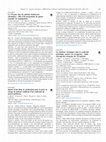
Child Abuse & Neglect, 2021
Il existe chez les patients douloureux chroniques un déconditionnement aérobie qui participe au m... more Il existe chez les patients douloureux chroniques un déconditionnement aérobie qui participe au maintien en situation d'incapacité et de handicap. Notre objectif est d'étudier la variation de la VO 2 max après 4 semaines de réadaptation chez des patients douloureux chroniques. Méthodes.-Il s'agit d'une étude prospective sur 121 patients douloureux chroniques (lombalgie chronique, syndrome douloureux chronique du membre supérieur ou syndrome douloureux chronique multifocal). Nous avons mesuré la VO 2 max à l'aide d'un analyseur d'échanges gazeux au cours d'une épreuve d'effort sur cycloergomètre avant et après 4 semaines de réadaptation associant travail aérobie, renforcement musculaire, ergothérapie et assouplissements. Résultats.-Après un programme de 4 semaines, nous avons observé une amélioration statistiquement significative de la VO 2 au seuil SV1 (p = 0,0007) et de la VO 2 max (SV2) (p < 0,0001) (22,2 AE 5,8 mL/kg/min avant réadaptation vs 23,9 AE 5,2 mL/kg/min après), et une amélioration de la répartition des patients selon les catégories de la classification de Shvartz : 88 patients (72,7 %) étaient en catégorie « 1 » (la plus faible) avant réadaptation pour 60 patients (49,6 %) après, 24 (19,8 %) en catégorie « 2 » avant pour 42 (34,7 %) après. Quatorze pour cent des patients avaient une VO 2 max inférieure à 17 mL/kg/min avant réadaptation pour seulement 8,3 % après réadaptation. Discussion.-Le programme de réadaptation proposé permet une amélioration des capacités aérobies chez les patients douloureux chroniques. Cependant, la VO 2 max à la fin du programme reste, chez 120 patients, inférieure à la moyenne pour l'âge et le sexe. La poursuite d'une activité aérobie régulière est donc indispensable au décours du programme de réadaptation.
Behavioral Sciences & The Law, Jul 1, 2020
This research uses experimental methods to gauge how different facets of essentialist thinking to... more This research uses experimental methods to gauge how different facets of essentialist thinking toward (1) types of offending and (2) biosocial risk factors for criminality predict lay punishment support. A randomized between-subjects experiment using contrastive vignettes was conducted with members of the general public (N = 897). Overall, as hypothesized, aspects of essentialist thinking, particularly informativeness, continuity, immutability, and discreteness, toward both biosocial risk factors and types of offending behavior generally predicted more severe punishments surrounding retribution, incapacitation, and deterrence. Yet,
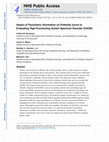
Journal of Mental Health Research in Intellectual Disabilities, May 28, 2015
During a trial involving an offender with a mental disorder, jurors are often required to evaluat... more During a trial involving an offender with a mental disorder, jurors are often required to evaluate information on the disorder and its characteristics. This evaluation relies on how jurors understand and synthesize psychiatric and other evidence on the disorder and this information's impact on the case, an offender's culpability, and the rendered verdict. The importance of this evaluation is further highlighted when jurors are faced with evaluating a disorder that may be associated with criminal actions of diagnosed offenders, such as high-functioning autism spectrum disorder (hfASD). We designed a three-part survey to assess potential jurors' attitudes concerning an offender's diagnosis with hfASD in terms of perceptions and decisions surrounding legal and moral responsibility, personal characteristics of the offender, the introduction of psychiatric and genetic information, and the condition's influence on the facts of the case. A sample of 623 juryeligible U.S. adults completed the survey. We found the majority of participants were influenced by the information provided on hfASD. Most respondents indicated that hfASD diagnosis should generally not affect the legal responsibility of an offender, but many reported the disorder as a mitigating factor when evaluating moral responsibility and legal consequences for criminal actions. Respondents reported favorable and sympathetic perceptions of individuals with autism and associated characteristics but were unsure, even after the presentation of psychiatric information on hfASD, if these disorders should be classified as "mental illness." Further, the majority reported their views were in some way influenced by the fact that hfASD has potential genetic origins.









Uploads
Papers by Colleen M Berryessa
Trying to repair the harm caused by the War on Drugs and rhetoric from the media in 2024, there is a strong push for the decriminalization and legalization of several drugs across the United States. For cannabis in particular, efforts have been made to advocate for its legalization federally. In the criminal-legal system, many political leaders and legislators have actively attempted to advocate for and enforce policies that release individuals from prison who have been incarcerated for minor drug offenses or are affected by unjust sentencing practices. Combined with nationwide efforts to promote research on the use of drugs for medicinal purposes, as well as the problems of drug abuse and addiction, a more progressive and optimistic approach to drug use has begun and continues to grow across the United States. The social and political forces that have historically shaped attitudes toward drug use and punishment are crucial to understanding the direction of U.S. drug policies in the early 21st century and why the pendulum continues to swing.
Methods: This paper reports findings from a national U.S. sample of appellate court cases across 46 states (n = 710) that involved mental health evidence. We collected detailed data on judge and defendant characteristics, type and severity of mental disorders, state sociopolitical ideologies, and legal factors such as offense and plea type and criminal history. We used a mixed quantitative approach, including machine learning, to examine how these intricate factors influence sentencing outcomes.
Results: A combination of linear regressions and supervised learning techniques reveals important differences in sentencing outcomes based on the type of mental disorder as well as the majority political ideology of states. We additionally show that, as compared to arguing no mental health evidence, having a mental disorder generally did not yield significant differences in sentencing.
Conclusions: Both a potential lack of scientific comprehension and the influence of sociopolitical ideology may help explain why certain mental disorders are aggravating in punishment contexts. We also discuss the advantages and limitations of supervised learning and classification trees for studying judicial decisions.
on de-biasing humans, machines, and improving overall sentencing decision-making.
criminal justice stakeholders who were integral in creating and implementing the New Jersey Public Health Emergency Credits Act (2020). Stakeholders, including police administrators, corrections administrators, parole administrators, prison health administrators, and reentry service organization administrators, were interviewed. Stakeholders shared their viewpoints through three phases of the bill (pre-implementation, implementation, and post-implementation), highlighting their struggles with the lack of time and resources to support individuals upon their release, which later impacted their supervision capabilities. Implications suggest that future decarceration efforts may benefit from augmented planning and coordination.
Trying to repair the harm caused by the War on Drugs and rhetoric from the media in 2024, there is a strong push for the decriminalization and legalization of several drugs across the United States. For cannabis in particular, efforts have been made to advocate for its legalization federally. In the criminal-legal system, many political leaders and legislators have actively attempted to advocate for and enforce policies that release individuals from prison who have been incarcerated for minor drug offenses or are affected by unjust sentencing practices. Combined with nationwide efforts to promote research on the use of drugs for medicinal purposes, as well as the problems of drug abuse and addiction, a more progressive and optimistic approach to drug use has begun and continues to grow across the United States. The social and political forces that have historically shaped attitudes toward drug use and punishment are crucial to understanding the direction of U.S. drug policies in the early 21st century and why the pendulum continues to swing.
Methods: This paper reports findings from a national U.S. sample of appellate court cases across 46 states (n = 710) that involved mental health evidence. We collected detailed data on judge and defendant characteristics, type and severity of mental disorders, state sociopolitical ideologies, and legal factors such as offense and plea type and criminal history. We used a mixed quantitative approach, including machine learning, to examine how these intricate factors influence sentencing outcomes.
Results: A combination of linear regressions and supervised learning techniques reveals important differences in sentencing outcomes based on the type of mental disorder as well as the majority political ideology of states. We additionally show that, as compared to arguing no mental health evidence, having a mental disorder generally did not yield significant differences in sentencing.
Conclusions: Both a potential lack of scientific comprehension and the influence of sociopolitical ideology may help explain why certain mental disorders are aggravating in punishment contexts. We also discuss the advantages and limitations of supervised learning and classification trees for studying judicial decisions.
on de-biasing humans, machines, and improving overall sentencing decision-making.
criminal justice stakeholders who were integral in creating and implementing the New Jersey Public Health Emergency Credits Act (2020). Stakeholders, including police administrators, corrections administrators, parole administrators, prison health administrators, and reentry service organization administrators, were interviewed. Stakeholders shared their viewpoints through three phases of the bill (pre-implementation, implementation, and post-implementation), highlighting their struggles with the lack of time and resources to support individuals upon their release, which later impacted their supervision capabilities. Implications suggest that future decarceration efforts may benefit from augmented planning and coordination.